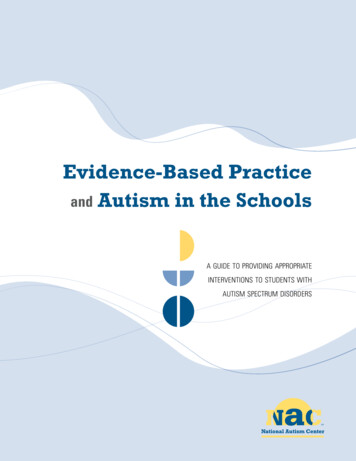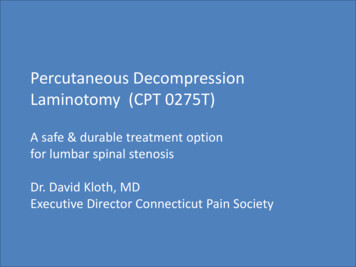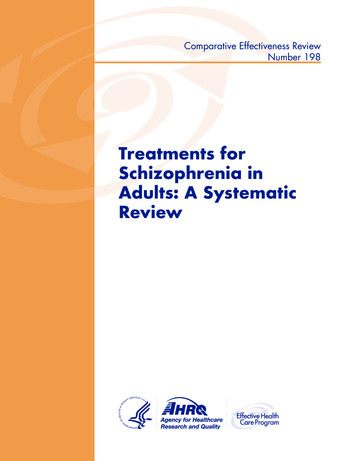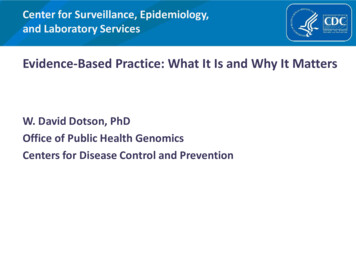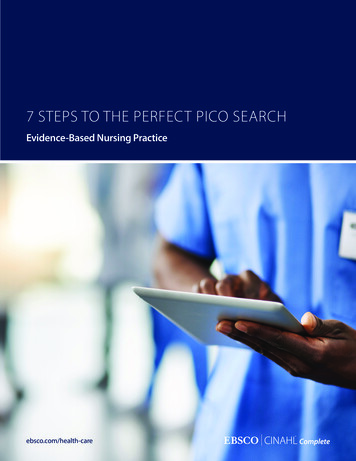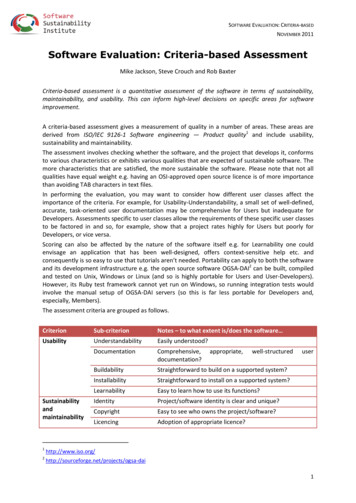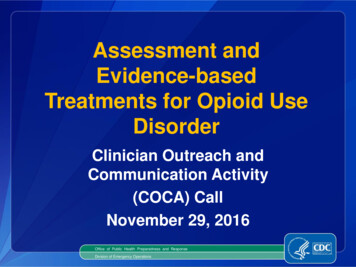
Transcription
Assessment andEvidence-basedTreatments for Opioid UseDisorderClinician Outreach andCommunication Activity(COCA) CallNovember 29, 2016Office of Public Health Preparedness and ResponseDivision of Emergency Operations
Accreditation StatementsCME: The Centers for Disease Control and Prevention is accredited by the Accreditation Council for Continuing MedicalEducation (ACCME ) to provide continuing medical education for physicians. The Centers for Disease Control and Preventiondesignates this live activity for a maximum of 1.0 AMA PRA Category 1 Credit . Physicians should only claim creditcommensurate with the extent of their participation in the activity.CNE: The Centers for Disease Control and Prevention is accredited as a provider of Continuing Nursing Education by theAmerican Nurses Credentialing Center's Commission on Accreditation. This activity provides 1.0 contact hour.IACET CEU: The Centers for Disease Control and Prevention is authorized by IACET to offer 1.0 CEU's for this program.CECH: Sponsored by the Centers for Disease Control and Prevention, a designated provider of continuing education contacthours (CECH) in health education by the National Commission for Health Education Credentialing, Inc. This program isdesigned for Certified Health Education Specialists (CHES) and/or Master Certified Health Education Specialists (MCHES) toreceive up to 1.0 total Category I continuing education contact hours. Maximum advanced level continuing education contacthours available are 0. CDC provider number 98614.CPE: The Centers for Disease Control and Prevention is accredited by the Accreditation Council for Pharmacy Education asa provider of continuing pharmacy education. This program is a designated event for pharmacists to receive 0.1 CEUs inpharmacy education. The Universal Activity Number is 0387-0000-16-210-L04-P and enduring 0387-0000-16-210-H04-P coursecategory. Course Category: This activity has been designated as knowledge-based. Once credit is claimed, an unofficialstatement of credit is immediately available on TCEOnline. Official credit will be uploaded within 60 days on the NABP/CPEMonitorAAVSB/RACE: This program was reviewed and approved by the AAVSB RACE program for 1.0 hours of continuing educationin the jurisdictions which recognize AAVSB RACE approval. Please contact the AAVSB RACE Program at race@aavsb.org ifyou have any comments/concerns regarding this program’s validity or relevancy to the veterinary profession.CPH: The Centers for Disease Control and Prevention is a pre-approved provider of Certified in Public Health (CPH)recertification credits and is authorized to offer 1 CPH recertification credit for this program.
Continuing Education DisclaimerCDC, our planners, presenters, and their spouses/partners wish todisclose they have no financial interests or other relationships withthe manufacturers of commercial products, suppliers of commercialservices, or commercial supporters, with the exception of Dr. MarkSullivan and Dr. Joseph Merrill. They would like to disclose that theiremployer, the University of Washington, received a contract paymentfrom the Centers for Disease Control and Prevention.Planners have reviewed content to ensure there is no bias.This presentation will include discussion of the unlabeled use of aproduct or products under investigational use.
ObjectivesAt the conclusion of this session, the participant willbe able to: Describe Diagnostic and Statistical Manual of MentalDisorders, Fifth Edition (DSM-5) assessment criteria for opioiduse disorder.Discuss the evidence for opioid use disorder medicationassisted treatment.List types of medications and settings used in medicationassisted therapy.Review considerations for buprenorphine, methadone, andnaltrexone use for opioid use disorder.Outline the opioid taper process used when opioid harmsexceed opioid benefits but opioid use disorder DSM-5 criteriaare not met.
Save-the-DatesMark your calendar for the upcoming opioid prescribing callsDateTopicNovember 29Assessment and Evidence-basedTreatments for Opioid Use DisorderRisk Mitigation StrategiesDecember 6December 13Effective Communication with Patientsabout Opioid Therapy
TODAY’S PRESENTERDeborah Dowell, MD, MPHSenior Medical AdvisorNational Center for Injury Prevention and ControlCenters for Disease Control and Prevention
TODAY’S PRESENTERJoseph O. Merrill, MD, MPHAssociate ProfessorDepartment of MedicineUniversity of WashingtonHarborview Medical Center
TODAY’S PRESENTERMark Sullivan, MD, PhDProfessor, Psychiatry and Behavioral SciencesAnesthesiology and Pain MedicineBioethics and HumanitiesUniversity of Washington
DisclaimerThe findings and conclusions in this presentation are those ofthe author(s) and do not necessarily represent the views of theCenters for Disease Control and Prevention/the Agency forToxic Substances and Disease Registry
National Center for Injury Prevention and ControlCDC Guideline for PrescribingOpioids for Chronic Pain:Assessment of opioid use disorderand referral to evidence-based treatmentDeborah Dowell, MD, MPHNovember 29, 2016
CDC Guideline forPrescribing Opioidsfor Chronic Pain
JAMA: The Journal ofAmerican MedicalAssociationDeborah Dowell, TamaraHaegerich, and Roger ChouCDC Guideline for PrescribingOpioids for Chronic Pain—United States, 2016Published online March 15, 2016
Evidence Prevalence of DSM-IV opioid dependence in primarycare settings among patients with chronic pain onopioid therapy: 3%–26% Opioid agonist treatment prevents relapse– Methadone (full opioid agonist)– Buprenorphine (partial opioid agonist) Naltrexone (opioid antagonist) can be effective inpatients who are able to continue treatment
Treat patients for opioiduse disorder (OUD) if needed Clinicians should offer or arrange evidence-basedtreatment (usually medication-assisted treatment withbuprenorphine or methadone in combination withbehavioral therapies) for patients with opioid use disorder.(Recommendation category A: Evidence type: 2)
Opioid use disorder Previously classified as opioid abuse or opioiddependence (DSM-IV) Defined in DSM-5 as a problematic pattern of opioiduse leading to clinically significant impairment ordistress– manifested by at least two defined criteria– occurring within a year
Opioid Use Disorder diagnostic criteria[first 9 of 11 criteria]A problematic pattern of opioid use leading to clinically significant impairment or distress, asmanifested by at least two of the following, occurring within a 12-month period:1. Opioids are often taken in larger amounts or over a longer period than was intended.2. There is a persistent desire or unsuccessful efforts to cut down or control opioid use.3. A great deal of time is spent in activities necessary to obtain the opioid, use the opioid, orrecover from its effects.4. Craving, or a strong desire or urge to use opioids.5. Recurrent opioid use resulting in a failure to fulfill major role obligations at work, school, orhome.6. Continued opioid use despite having persistent or recurrent social or interpersonal problemscaused or exacerbated by the effects of opioids.7. Important social, occupational, or recreational activities are given up or reduced because ofopioid use.8. Recurrent opioid use in situations in which it is physically hazardous.9. Continued opioid use despite knowledge of having a persistent or recurrent physical orpsychological problem that is likely to have been caused or exacerbated by the substance.From SM-5-Opioid-Use-Disorder-Diagnostic-Criteria.pdf
Opioid Use Disorder diagnostic criteria[last 2 of 11 criteria]A problematic pattern of opioid use leading to clinically significant impairment or distress, asmanifested by at least two of the following, occurring within a 12-month period:10. Tolerance, as defined by either of the following:a. A need for markedly increased amounts of opioids to achieve intoxication or desiredeffect.b. A markedly diminished effect with continued use of the same amount of an opioid.Note: This criterion is not considered to be met for those taking opioids solely under appropriatemedical supervision.11. Withdrawal, as manifested by either of the following:a. The characteristic opioid withdrawal syndrome (refer to Criteria A and B of the criteria setfor opioid withdrawal).b. Opioids (or a closely related substance) are taken to relieve or avoid withdrawalsymptoms.Note: This criterion is not considered to be met for those individuals taking opioids solelyunder appropriate medical supervision.From SM-5-Opioid-Use-Disorder-Diagnostic-Criteria.pdf
If you suspect opioid use disorder Discuss your concern with your patient Provide an opportunity for your patient to discloserelated concerns or problems Assess for opioid use disorder– Use DSM-5 criteria or– Arrange for assessment with a substance usedisorder specialist Do not dismiss patients from care—use theopportunity to provide potentially lifesavinginformation and interventions
If patient meets criteria for opioid use disorder,offer or arrange evidence-based treatment Treat with medication-assisted treatment(buprenorphine or naltrexone)or Arrange for medication-assisted treatment from an– Office-based provider (buprenorphine or naltrexone)or– Opioid treatment program (buprenorphine ormethadone maintenance therapy)
Buprenorphine (partial opioid agonist) Can be prescribed/dispensed for opioid use disorder byqualified clinicians with a DATA waiver Sublingual, buccal forms available with or without naloxone Initiate when patient in mild-moderate opioid withdrawal Most patients stabilized on 8 to 16 mg/day– MME thresholds in the CDC Guideline for PrescribingOpioids for Chronic Pain are NOT applicable to opioidagonist treatment of opioid use disorder Needs to be tapered gradually when discontinued
Methadone (long-acting opioid agonist) For treatment of opioid use disorder, can only bedispensed by an opioid treatment program (OTP) Patients need to go to OTP for methadone– usually daily early in therapy– limited use of take-home doses Length of time in methadone treatment– minimum of 12 months recommended– patients may require treatment for years– If stopped, must be gradual to prevent withdrawal
Naltrexone (opioid antagonist) Blocks effects of opioids if used--causes immediate withdrawal– Use only in nonpregnant adults– Do not start if patient is taking or recently took opioidsor has signs of withdrawal– Start 3-10 days after last use (longer if longer-acting opioids) Most effective in closely supervised patients Naltrexone dosing forms for opioid dependence:– Oral tablet (daily)– Long-acting injectable naltrexone (every 4 weeks IM)
Resources for treatment SAMHSA’s buprenorphine physician locator(http://buprenorphine.samhsa.gov/bwns locator) SAMHSA’s Opioid Treatment Program ry.aspx) SAMHSA’s Provider Clinical Support System for OpioidTherapies (http://pcss-o.org) SAMHSA’s Provider’s Clinical Support System forMedication-Assisted Treatment (http://pcssmat.org) HHS Treatment & Recovery d-recovery/)
Free electronic resources from SAMHSA athttp://store.samhsa.gov/ Medication-Assisted Treatment of Opioid Use DisorderPocket Guide Advisory: Sublingual and Transmucosal Buprenorphinefor Opioid Use Disorder: Review and Update Clinical Use of Extended-Release Injectable Naltrexonein the Treatment of Opioid Use Disorder: A Brief Guide
Resources for treatment MATx: A mobile app fromSAMHSA to support medicationassisted treatment of opioid usedisorder Available on Google Play andthe App Store
Assess your community’s treatment capacityfor opioid use disorder Identify treatment resources for opioid use disorder inyour community Work with other clinicians to ensure sufficienttreatment capacity at the practice level Consider training and obtaining a DATA waiver thatallows you to prescribe buprenorphine to treat patientswith opioid use disorder
How to qualify for a waiver to prescribebuprenorphine Complete required training (8 hours) in the treatmentand management of patients with opioid use disordersthrough ASAM, SAMHSA, or other organization(See esources/buprenorphinephysician-training) Apply for a waiver through SAMHSA(See buprenorphine.samhsa.gov)
What about problematic opioid use that doesnot meet criteria for opioid use disorder? Offer to taper and discontinue opioids For patients who choose to but are unable to taper– Reassess for opioid use disorder– Offer opioid agonist therapy if criteria are met
Connect With UsFind more information on drug overdose andthe Guideline: rescribing/guideline.htmlAre you on Twitter? Follow @DebHouryCDC and @CDCInjury foruseful information and important Guidelineupdates.Find out more about Injury Center socialmedia: www.cdc.gov/injury/socialmedia
Patients with opioid use disorderJOSEPH O. MERRILL, MD, MPHUNIVERSITY OF WASHINGTONHARBORVIEW MEDICAL CENTERDEPARTMENT OF MEDICINE
Opioid use disorder case Ron, a 50 year old man with a history of alcohol usedisorder in remission and long term high dose opioidtreatment after a work accident years ago Quit drinking alcohol after falling off a ladder at workand sustaining multiple traumatic injuries, resulting inhigh dose opioid therapy that was never tapered Taking morphine ER 90mg TID and short actingmorphine 30 mg up to 4 per day Total opioid dose 390mg MED
Opioid use disorder case Since transfer from another provider, aberrantbehaviors have been noted: Urine test negative for prescribed morphine and positivefor oxycodone. The patient admits to “borrowing”oxycodone from a friend after running out of medicationdue to a pain flare. Admits to difficulty controlling medication use when painflares, resulting in withdrawal when medication runs out. Prescription Monitoring Program shows two additionalprescribing physicians. The patient denies obtaining thesemedications.
Opioid use disorder diagnosis Takes more than intended – yes Physically hazardous – no Desire to cut down – no Time spent – noUse despite medical orpsychological problems – no Craving – ? (“it’s the pain”) Tolerance – yes Leads to role problems – “Maybe” Withdrawal - yes Use despite social problems – ? (“it’s the pain”) Important activities given up – ? (It’s the pain”)
Opioid use disorder diagnosis Presenting the diagnosis: “You meet the criteria for an opioid use disorder” “Trouble controlling the medication makes it unsafe” “The medicine has become a problem in itself”Discussing treatment options “Continuing the current treatment is not safe, but you doneed opioid medication for the use disorder” “Stabilizing the brain with medication can help a lot” “Other kinds of pain treatments will work better if the brainis more stable”
Helping patients accept thediagnosis “All kinds of people have opioid use disorder” “I don’t see it as a bad person doing a bad thing” “Sometimes the medications cause problems due togenetic factors that we cannot anticipate” “Getting help for this should be like getting help for anyother chronic medical problem”
Opioid use disorder treatment:buprenorphine/naloxone Usually recommended as first medication option –fewer barriers to treatment Far safer than high dose opioids for pain Effective no matter how high the prescribed opioiddose Ideally provided by the same physician (so get trained!) Insurance coverage for use disorder, not for pain Butrans patch is approved for pain, not opioid usedisorder, and doses are much lower than for usedisorder
Opioid use disorder treatment:methadone maintenance Most effective treatment in retaining patients Higher barrier to treatment Must coach patients to seek addiction treatment ratherthan pain management Provides maximum structure for patients with moresevere psychosocial challenges Discuss take-home dose opportunities
What about high dose prescribedmethadone? Methadone has long-acting metabolites that increasethe risk of precipitated withdrawal when startingbuprenorphine Tapering to 30-40 mg daily increases risk of withdrawaland illicit opioid use Higher dose prescribed methadone patients will likelyrequire transfer to methadone maintenance Can offer to continue prescription pending transfer, butmay require coerced transfer (transfer or taper)
Conclusions Opioid use disorder diagnoses can be difficult in thesetting of long-term opioid prescribing Pharmacotherapy is the most important aspect ofeffective opioid use disorder treatment Obtaining a waiver to prescribe buprenorphine is animportant management tool when there is cooccurring opioid use disorder and chronic pain Facilitating OUD treatment requires effective patientcommunication
What about problematic opioid usethat does not meet criteria for OUD?MARK D. SULLIVAN, MD, PHDUNIVERSITY OF WASHINGTONPSYCHIATRY AND BEHAVIORAL SCIENCESANESTHESIOLOGY AND PAIN MEDICINEBIOETHICS AND HUMANITIES
Case of problematic opioid use Suzanne, 46 yr old woman with chronic neck painfollowing “whiplash” injury during a motor vehicle crash5 years earlier She has been on opioids for these 5 years, prescribedby a colleague of yours that has recently retired Her opioid dose has gradually escalated due torequests, pain “flare-ups”, and other minor MVAs She is currently taking ER oxycodone 40mg BID, plusoxycodone 5mg for breakthrough pain, up to 5/day Total opioid dose 157.5mg MED
Case of problematic opioid usethe good news She has no history of illicit drug use and her UDTs havenot shown any illicit drugs She has not sought out multiple prescribers for heropioids nor has she been going to the ED for extradoses, this is confirmed by consulting the statePrescription Drug Monitoring Program (PDMP) She had some early refill requests years ago, but yourcolleague told her these were not allowed and she hasmade no further requests
Case of problematic opioid usethe bad news She now reports that her pain intensity is 8/10, pain interference withgeneral activities is 7/10, and pain interference with enjoyment oflife is 9/10. She is asking for an increase in her oxycodone She is 5’4”, 245lb, and her husband complains of her snoring SHE LIKELY HAS SLEEP APNEAShe smokes cigarettes, about 1PPD for 25 years HER OPIOID THERAPY IS NOT WORKINGAS A SMOKER, SHE IS AT HIGH RISK FOR BAD OPIOID OUTCOMESShe takes alprazolam 1mg PRN for panic attacks OPIOIDS PLUS BENZODIAZEPINES GREATLY INCREASE RISK OF FATAL OD
Opioid taper is appropriate for thispatient After 5 years of opioid therapy, she is not doing well.Her pain scores are high and she is seeking moreopioids. She is at high risk for serious adverse events due to likelysleep apnea, tobacco use, benzodiazepine use These risks will decrease with opioid dose reduction Her pain level may not increase with opioid dosereduction and may decrease
Introducing opioid taper to thepatient Explain that you can see that her opioid therapy is notworking and that she is at high risk for bad events. Thesewill not get better with further dose increases, but mayget better with opioid dose decrease. It is usually better to introduce the idea of opioid taperat the visit before the visit when you start the taper. Pledge that you will not abandon the patient and thatyou will make sure that she has adequate pain relief. Patients are afraid of overwhelming pain or withdrawaland need to be reassured this will not happen.
Negotiating opioid taper with thepatient It is always best to get the patient to agree to try taper. Tell the patient that there is no need to rush the taper.She can decide to pause the taper at any point. Butonce the taper starts, opioid doses will not beincreased. Allow her to choose whether long-acting or short-actingopioids are tapered first. Most patients choose to taperlong-acting first. She can also be offered the choice oftapering her benzodiazepine first. You might begin with a taper of 10% of the originaldose per month, but this can be negotiated.
Making opioid taper a success forboth prescriber and patient Explore her own ambivalence about opioid therapy.What concerns does she have about opioids? (PODS) Monitor depression, anxiety and insomnia before andduring taper. If these are controlled, pain does notusually increase. You may need to start or adjustantidepressant medication. Offer the patient pain self-management resources Referral Books Websites
Conclusions Opioid taper is appropriate for patients without OUDwhose opioid therapy has low efficacy and high risks These patients are often ambivalent about opioidtherapy and have their own reasons for tapering thatcan be elicited and supported Patients are fearful of opioid taper and need to bereassured that you will not abandon them to their pain Attention to depression, anxiety, and insomnia is crucialfor successful opioid taper
To Ask a Question Using the Webinar System “Click” the Q&A tab at the top left of the webinar tool bar “Click” in the white space “Type” your question “Click” ask On the Phone Press Star (*) 1 to enter the queue State your name Listen for the operator to call your name State your organization and then ask your question
Thank you for joining!Centers for Disease Control and PreventionAtlanta, Georgiahttp://emergency.cdc.gov/coca
Today’s webinar will be archivedWhen: A few days after the live callWhat: All call recordings (audio, webinar, andtranscript)Where: On the COCA Call llinfo 112916.asp51
Guideline for Prescribing Opioidsfor Chronic Pain Call SeriesListen to recordings from previous calls and earn free continuing educationDateJune 22TopicGuideline for Prescribing Opioids for Chronic PainJuly 27August 3Non-Opioid TreatmentsAssessing Benefits and Harms of Opioid TherapyAugust 17Dosing and Titration of Opioids
Upcoming COCA Callregistration is not requiredUpdated CDC Zika Laboratory Testing GuidanceDate: Thursday, December 1, 2016 Time: 2:00 – 3:00 pm (Eastern) Presenters: Dr. Grace Kubin – Association of Public Health Laboratories Dr. Matthew J. Binnicker– American Society of Microbiology Dr. Christy Ottendorfer– CDChttp://emergency.cdc.gov/coca
Continuing Education for COCA CallsAll continuing education (CME, CNE, CEU, CECH, ACPE, CPH, andAAVSB/RACE) for COCA Calls are issued online through the CDC Training& Continuing Education Online system (http://www.cdc.gov/TCEOnline/).Those who participated in today’s COCA Call and who wish to receivecontinuing education should complete the online evaluation by December28, 2016 with the course code WC2286. Those who will participate in theon demand activity and wish to receive continuing education shouldcomplete the online evaluation between December 29 , 2016 andNovember 28, 2018 will use course code WD2286.Continuing education certificates can be printed immediately uponcompletion of your online evaluation. A cumulative transcript of allCDC/ATSDR CE’s obtained through the CDC Training & ContinuingEducation Online System will be maintained for each user.
Join the COCAMailing ListReceive information about: Upcoming COCA Calls Health Alert Network notices CDC public health activations Emerging health threats Emergency preparedness andresponse conferences andtraining opportunitieshttp://emergency.cdc.gov/coca
Join Us onFacebookCDC Facebook pagefor clinicians! “Like”our page today tolearn about upcomingCOCA Calls, CDCguidance andrecommendations,and other health alertsCDC Clinician Outreach and Communication achAndCommunicationActivity
Objectives At the conclusion of this session, the participant will be able to: Describe Diagnostic and Statistical Manual of Mental Disorders, Fifth Edition (DSM-5) assessment criteria for opioid use disorder. Discuss the evidence for opioid use disorder medication- assisted treatment. List types of medications and settings used in medication- .


